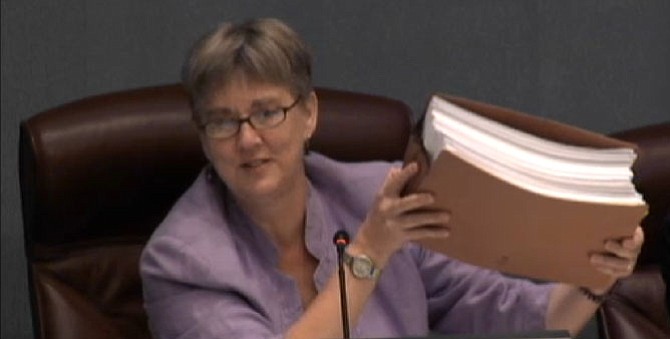County Board Chair Mary Hynes holds a stack of letters from the public on the Affordable Housing Master Plan. Photo Contributed
“Mi Voz Cuenta”
The Arlington County Board chambers were filled beyond capacity, to the point of having to open a second room with live-streaming of the meeting, largely with local residents wearing black and yellow shirts with the Spanish for “My Voice Counts” emblazoned across the front. Many of the residents told their stories of the struggle to find a place to live within Arlington County, some through a Spanish translator. It was a passionate representation of the lives affected by the County Board vote on Sept. 19 to approve Arlington’s first Affordable Housing Master Plan.
“Arlington is a multicultural and economically diverse county today, it may not be so tomorrow,” said Claudia Del Gadio, a resident from Columbia Pike. “We deserve to live in Arlington county. We build your houses, we take care and teach your children, we make your pupusas. Don’t push us out.”
The Affordable Housing Master Plan includes three goals: increasing the supply of affordable housing, ensuring access to housing, and contributing to a sustainable community.
The question of supply addressed ownership as well as rental options. Between 2000 and 2013, Arlington’s affordable rental housing supply fell from 23,000 to 10,000. The Affordable Housing Master Plan sets the target for affordable rental housing at 22,800 units by 2040.
The primary topics of discussion around providing access and ensuring sustainability largely centered on how to incorporate the new affordable housing into the existing Arlington communities. According to Russell Danao-Schroeder, a senior housing planner for Arlington County, geographic distribution was one of the most controversial topics during the plan’s development. The Affordable Housing Master Plan calls for no new affordable housing units in existing areas of concentrated poverty, classified in the document as neighborhoods with three times the average poverty rate for Arlington.
The geographic spread of the new affordable housing proved only marginally less controversial at the County Board meeting. While the vast majority of public speakers who commented on the plan expressed their support, a few expressed concerns about how the plan would affect the existing neighborhood communities.
“It’s heartening to see the opportunists here who have taken the opportunity to get taxpayer subsidies to housing and is now taking the opportunity to get more,” said Bernard Berne. “There’s plenty or market rate affordable housing in Herndon. Silver Line is going to Herndon within three years … They have the affordable housing, they just have to commute. I have an hour and a half commute just so I don’t have to be in a committed affordable housing unit. What this plan says is to put affordable housing near the transit. They’ll live here and work in D.C. Don’t put things like this near transit, you give it to the opportunists.”
Berne emphasized that, while he said he had no problem with the residents of affordable housing, he had deep concerns about the density. For the most part, however, the discussion from the County Board tended to favor Del Gadio and the plight of Arlington residents struggling for housing options. When discussion was raised over buffer zones between affordable housing residences and other housing, County Board member Jay Fisette balked at the idea.
““I think the testimony we heard today from 95 percent of the people that were here was far more compelling than the testimony you just referenced,” said Fisette. “We saw the human side of this. What is wrong with someone at 30 or 40 percent of median income being in the community? We heard some incredible testimony, as compelling as anything I’ve ever heard up here.”
While the plan itself carried no financial obligation in its passage, it did lay out options for funding of affordable housing programs. Between 2010 and 2014, the average funding to the Affordable Housing Investment Fund (AHIF) was $8 million. In 2015, funding from the county increased to $13 million. The plan’s recommendation is to maintain or increase this level of funding to AHIF. The plan also highlights that for every dollar of county funding, AHIF can often leverage $3 of private funding to housing development projects.
County Board Chair Mary Hynes noted that the plan had more feedback from commissions than any other item she’d seen presented to the County Board. While the plan was met with universal approval by the commissions, it wasn’t without concerns from some. Doris Ray from the Disability Advisory Commission expressed concerns about the lack of focus on disability accessibility to the new affordable housing.
Kirit Mookerjee, chair of the Tenant-Landlord Commission, summarized the discussion from many members of Arlington’s various boards and commissions.
“[We’re] not pleased with every part of this plan,” said Mookerjee, “but it’s better than not having a plan.”
